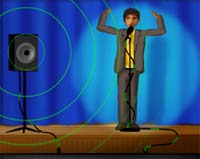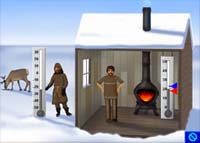Global Climate Change and Energy - Feedback
Have you ever been in an auditorium when someone steps up to a microphone and begins to speak, only to be drowned out by a loud whistle?
|
Click on the image for an animation. Change the volume and see what happens. |
When the man speaks, the sound of his voice is picked up by the microphone. It is amplified and emerges from the loudspeaker. Some of the sound from the loudspeaker also goes into the microphone. It is "fed back" into the amplifier circuit. If the volume is not set too high, everything is fine. The amplifier even gets a bit of a boost by having the microphone and speaker in the same room.
But if there is too much amplification, things go out of control. The louder output from the speaker causes a greater input to the microphone…
…which causes a louder output from the speaker…
……which results in a greater input to the microphone…
………which causes a louder output from the speaker…
…………
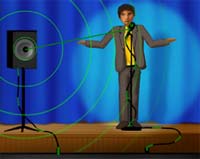 |
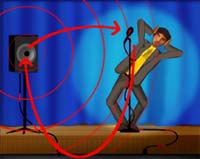 |
The limit is that there is a maximum volume that the system can produce. Or, someone intervenes and turns down the volume.
This is called a positive or reinforcing feedback loop. An increase of some factor at one point in the loop causes an increase at the next step. This can go on until some external factor intervenes, or the process may be self-limiting.
|
|
|||
 |
Digging Deeper |
||
| Find out more about | |||
|
|
|||
|
|
|||
Feedback shows up in many situations. It plays a significant role in the Earth’s climate system, for example.
Arctic ice ebbs and grows with the seasons. There is more ice cover in the dark winter and less in the summer when the Sun shines and melts some of the ice. Imagine that this cycle is stable. Each winter the ice pack grows to about the same size and then shrinks by the same amount each summer.
|
Arctic Sea Ice: The images below show the extent of the Arctic sea ice on two different days. Click on either image to see an animation of the sea ice day to day from September 28, 2003, to May 10, 2004. (The file is 21 MB.) The gray areas are ice. Darker gray indicates older ice. The wispy white areas are clouds. The black dot is centered on the North Pole. There is no data for that area. |
||
|
|
Now let’s imagine that the average yearly Arctic water temperature increases slightly. This could cause more ice to melt in summer and less to form in winter. You might think that the situation would stabilize with a somewhat smaller ice pack. But there’s more to it.
When sunlight reaches the Earth, some is reflected back into space while some is absorbed. The amount that is reflected is known as the “albedo.” It depends upon the characteristics of the surface. Ice and snow are highly reflective and so produce greater albedo; open water is less so, producing lesser albedo. The larger area of open water caused by an increase in water temperature reflects less and absorbs more of the Sun’s energy than the ice that used to be there. As a result, the water temperature rises further.
This causes more ice to melt…
…which results in more open water…
……which absorbs more of the Sun’s energy…
………which causes the water temperature to rise further…
…………which causes more ice to melt…
……………
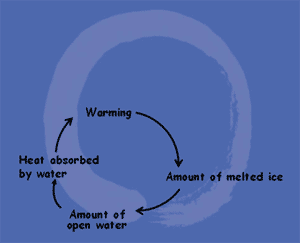
When does this cycle end? When there is no more summer sea ice, there can be no increase in the amount of melted ice. It is all gone. Some climate models do predict that by the end of the current century the Arctic Ocean will be ice-free in summer.
Not all feedback loops are of the positive reinforcing type. A negative or self-regulating feedback loop serves to control a system and keep it in balance. (When used to refer to kinds of feedback, the terms positive and negative do not have their familiar meaning of "good" and "bad". Positive means reinforcing. Negative refers to feedback structures that dampen and control change. These structures exhibit stabilizing, self-regulating, and self-correcting behavior.)
A good example of a negative or self-regulating feedback loop is a heating system with a thermostat.
|
Click on the image for an animation. Move the blue and red controls to see the effects on the inside temperature. |
Our building in western Siberia is heated by a gas stove. The temperature rises until it reaches the blue indicator on the thermostat. This switches the heat off. Because it is a very cold day, and some heat escapes the house, the temperature inside begins to drop. When it falls to the red indicator, the heat is turned on. This causes the temperature to rise…
…which eventually reaches the blue indicator…
……which turns the heat off…
………which causes the temperature to fall…
…………which eventually reaches the red indicator…
……………which turns on the heat…
………………which causes the temperature to rise…
…………………
Each step causes an opposite or negative action at the next step. More heat turns the heat off. Less heat turns the heat on.
In our animation it is possible to position the controls so that the blue turn-off indicator is below the red turn-on indicator. What do you think will happen? Try it.
Digging Deeper:Warming up with ice Imagine that you are in a restaurant in Houston, Texas, USA. It is excessively air-conditioned and very cold. You find the thermostat mounted on the wall, but it is enclosed in a cage so you can’t move the controls. You notice the glass of ice water on your table. You have an idea. There is a way to warm the place up. What do you do?… Find out more about why evaporation causes cooling… |
Our animation shows another example of a negative feedback loop. Position the red and blue controls so that the blue shut-off indicator is as high as it can go and the red turn-on indicator is as close to the bottom as possible. This causes the room to get very hot and then very cold. When it’s hot, the man sweats. When it’s cold, he folds his arms in front of him and he shivers. Why is this so?
The human body needs to maintain a constant internal temperature of 37°C (98.6°F) in order to function properly. Sweating tends to reduce body temperature because the evaporation of sweat causes cooling.
So if you are too hot, your body naturally sweats to bring the temperature down to the proper level.
When you are cold you shiver. The rapid contraction of your muscles generates heat, much as muscle movements when you exercise make you hotter. In the animation our friend folds his arms when it gets cold. You may have done this yourself. It is a natural response to feeling chilled. When you assume that position less of your body is exposed to the cold air, since your arms are against each other and against your chest. Remember, if you’re ever stuck out in the cold with friends, hug each other.
Related Article
This content has been re-published with permission from SEED. Copyright © 2025 Schlumberger Excellence in Education Development (SEED), Inc.


